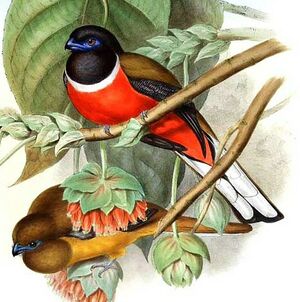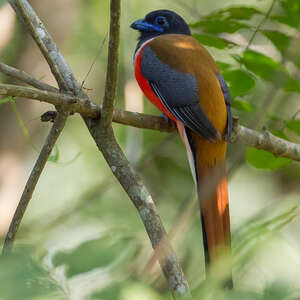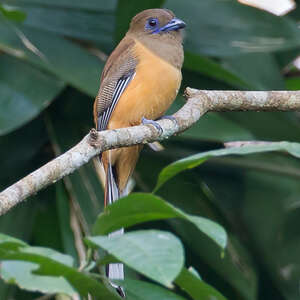Malabar Trogon
Harpactes fasciatus - Trogon de Malabar
Identification
The Malabar Trogon derives its name from the Indian coastline situated between Goa and the southernmost point of India, Comorin. The scientific name of its subfamily Harpactes probably comes from the Greek word 'harpax' meaning 'rapace', 'ravisseur' or 'voleur', while 'fasciatus' is a Latin word meaning 'striped'. Is it the 'striped bandit'? The scientific name remains somewhat enigmatic; our Malabar Trogon is rather far from a raptor, but its diet which is mostly carnivorous and insectivorous may justify the name. There is a strong dimorphism, the male measuring 30 cm; its head, cap, nape and throat are the same anthracite colour, with a blue-cobalt beak and a black tip on both mandibles. The dark brown iris is surrounded by a wide circle of the same blue as the beak; this circle is a bit wider on the back part of the eye, and, most notably, there is a distinctive mark of the Malabar Trogon, a strip of blue skin that underlines the eye, giving it a strange smile. A very clear white line separates the anthracite chest from the reddish-carmine belly, the mantle is brownish-red and the back is shaded in chamois-gold; the bird looks less spectacular from behind but the colour palette is extremely fine with brownish-red shades. The scapulars, of the same colour as the mantle, stand out against the horizontally vermiculated black coverts with thin white wavy lines; the remiges are black with very clear white margins. The lower rectrices are black at their base and white in the majority of their surface; generally, the bird has a white tail crossed with a black line at its end when seen from the front. The female is no less charming but with a more discrete elegance: its head, nape and chest are light brownish-olive and the same blue-cobalt - perhaps slightly lighter - tinges the orbital circle as well as the beak with its black tip; the same blue skin line underlines the eye.A white patch separates the chest from the golden yellow belly, the mantle is fawn, the back is close to the golden yellow shade of the belly, the wings inspire artists with horizontal fawn vermiculations on a dark brown background. The remiges are black and highlighted with white at the margins. The underside of the tail feathers are white, showing black bases which can have a black line in the middle, the upper tail feathers are light brown-brown, barred with black at the ends. The supreme coquetry of both sexes are the blue tarses that match perfectly with the beak and eye! Juveniles look like their mother, the chest and belly are light fawn, the wings are lightly spotted in brown and light yellow, the young males not yet having their black and white wings. Two subspecies are recognized, fasciatus, only in Sri Lanka which gives its name to the nominate species previously described, and malabaricus, in India, which has a black head and is a bit larger with a longer tail.
Subspecific information 3 subspecies
- Harpactes fasciatus fasciatus (Sri Lanka)
- Harpactes fasciatus malabaricus (w and s India)
- Harpactes fasciatus legerli (c India)
Foreign names
- Trogon de Malabar,
- Trogón malabar,
- republicano-do-malabar,
- Malabartrogon,
- malabári malájtrogon,
- Malabartrogon,
- Trogone del Malabar,
- ghatstrogon,
- Hindutrogon,
- dravčík pásikavý,
- trogon malabarský,
- Malabartrogon,
- intiantrogoni,
- trogon de l'Índia,
- sędzioł malabarski,
- Малабарский азиатский трогон,
- インドキヌバネドリ,
- 黑头咬鹃,
- ghatstrogon,
- 馬拉巴黑頭咬鵑,
Voice song and call
Habitat
The Malabar Trogon, even though it can be seen along the east coast of India at mid elevations, mostly stays at high altitudes; it can be found in the center of Sri Lanka between 1,500 and 2,000 meters or in the Nilgiris district in the state of Tamilnadu at 2,000 meters.
Behaviour character trait
Dietfeeding habits
Rather insectivorous (caterpillars, butterflies, beetles and all kinds of insects), it also consumes small amphibians and reptiles. It goes hunting at twilight, sometimes in small groups of 4 individuals or more, from a perch and can catch its prey in flight. It will also vary its diet of fruits and berries.
Reproduction nesting
From February to June in India and from March to May in Sri Lanka, the nest is located in dense forests. The Malabar Trogon will make its nest in a dead tree hole at a height of 3 to 6 m, the clutch is 2 to 4 eggs. Unfortunately, there is very little information about the incubation and its duration, it is thought that the couple incubates alternately.
Geographic range
Ssp fasciatus is only found in Sri Lanka, while ssp malabaricus is found in India (in the Western Ghats from Cape Comorin at the extreme south of India, in the states of Tamilnadu and Kerala up to Bombay). Another pocket is suitable for the observation of the Malabar Trogon: the Eastern Ghats from the south of Bengal to the north of Andhra Pradesh.
Threats - protection
IUCN conservation status
concern
in the Wild
threatened
evaluated
LC is considered to be fairly common in India, but its population is suffering from population growth and deforestation. One of its main strongholds where it thrives is the Thattakad Bird Sanctuary in the state of Kerala. In Sri Lanka, reserves help to preserve the Malabar Trogon and its population remains stable.
Sources of information
- IOC World Bird List (v15.1), Gill, F and D Donsker (Eds). 2025-12-07.
- A Natural history of the Trogonidae, Joseph M.Forshaw Albert Earl Gilbert
- Vol. 6 - Handbook of the Birds of the World, Josep del Hoyo-Andrew Elliott-Jordi Sargatal
- A Field Guide to the Birds of the Indian Subcontinent, Krys Kazmierczak, Ber Van Perlo
- xeno-canto, Sharing bird sounds from around the world,
- Avibase, Lepage Denis
- HBW Alive,
- Neotropical Birds Online,
- Wikipédia, Wikipedia, The Free Encyclopedia
- BirdLife International, BirdLife International
Other sources of interest
 Specification sheet created on
02/08/2023 by Anne et Gabriel Leboff
Specification sheet created on
02/08/2023 by Anne et Gabriel LeboffTranslation by AI Oiseaux.net
© 1996-2025 Oiseaux.net
- Accipitriformes
- Aegotheliformes
- Anseriformes
- Apodiformes
- Apterygiformes
- Bucerotiformes
- Caprimulgiformes
- Cariamiformes
- Casuariiformes
- Charadriiformes
- Ciconiiformes
- Coliiformes
- Columbiformes
- Coraciiformes
- Cuculiformes
- Eurypygiformes
- Falconiformes
- Galliformes
- Gaviiformes
- Gruiformes
- Leptosomiformes
- Mesitornithiformes
- Musophagiformes
- Nyctibiiformes
- Opisthocomiformes
- Otidiformes
- Passeriformes
- Pelecaniformes
- Phaethontiformes
- Phoenicopteriformes
- Piciformes
- Podargiformes
- Podicipediformes
- Procellariiformes
- Psittaciformes
- Pterocliformes
- Rheiformes
- Sphenisciformes
- Steatornithiformes
- Strigiformes
- Struthioniformes
- Suliformes
- Tinamiformes
- Trogoniformes





















